Synthesis and Characterization of Cerium Oxide Nanoparticles: Effect of Cerium Precursor to Gelatin Ratio
Abstract
:1. Introduction
2. Materials and Methods
2.1. Materials
2.2. Synthesis of Ceria Nanoparticles
2.3. Characterization of Ceria Nanoparticles
2.4. Hemocompatibility Assay
2.5. Blood Sample Collection
2.6. Reactive Oxygen Species Levels (ROS) in Erythrocytes
3. Results
3.1. Fourier Transform Infrared Spectroscopy
3.2. X-ray Diffraction Spectroscopy
3.3. Scanning Electron Microscopy
3.4. Transmission Electron Microscopy
3.5. Hemocompatibility Assay
3.6. Reactive Oxygen Species Assay
4. Discussion
5. Conclusions
Author Contributions
Funding
Institutional Review Board Statement
Informed Consent Statement
Data Availability Statement
Acknowledgments
Conflicts of Interest
References
- Science, N.; Council, T. National Nanotechnology Initiative—Leading To the Next Industrial Revolution. Microscale Thermophys. Eng. 2000, 4, 205–212. [Google Scholar]
- Thakur, S.; Patil, P. Rapid synthesis of cerium oxide nanoparticles with superior humidity-sensing performance. Sens. Actuators B Chem. 2014, 194, 260–268. [Google Scholar] [CrossRef]
- Pal, S.L.; Jana, U.; Manna, P.K.; Mohanta, G.P.; Manavalan, R. Nanoparticle: An overview of preparation and characterization. J. Appl. Pharm. Sci. 2011, 1, 228–234. [Google Scholar]
- Singh, K.R.B.; Nayak, V.; Sarkar, T.; Singh, R.P. Cerium oxide nanoparticles: Properties, biosynthesis and biomedical application. RSC Adv. 2020, 10, 27194–27214. [Google Scholar] [CrossRef]
- Thakur, N.; Manna, P.; Das, J. Synthesis and biomedical applications of nanoceria, a redox active nanoparticle. J. Nanobiotech. 2019, 17, 1–27. [Google Scholar] [CrossRef] [Green Version]
- Ramasamy, V.; Mohana, V.; Suresh, G. The synthesis and characterization of undoped and Ni doped CeO2 nanoparticles using sol-gel method. Int. J. Mater. Sci. 2017, 12, 2. [Google Scholar]
- Periyat, P.; Laffir, F.; Tofail, S.A.M.; Magner, E. A facile aqueous sol-gel method for high surface area nanocrystalline CeO2. RSC Adv. 2011, 1, 1794–1798. [Google Scholar] [CrossRef]
- Stoianov, O.O.; Ivanov, V.K.; Shcherbakov, A.B.; Stoyanova, I.V.; Chivireva, N.A.; Antonovich, V.P. Determination of cerium(III) and cerium(IV) in nanodisperse ceria by chemical methods. Russ. J. Inorg. Chem. 2014, 59, 15–23. [Google Scholar] [CrossRef]
- Keren Jiang, K.J. Fabrication and Catalytic Property of Cerium Oxide Nanomaterials. Master Thesis, University of Nebraska, Lincoln, NE, USA, 2011. Available online: https://digitalcommons.unl.edu/chemistrydiss/22.
- Cam, T.S.; Omarov, S.O.; Chebanenko, M.I.; Izotova, S.G.; Popkov, V.I. Recent progress in the synthesis of CeO2-based nanocatalysts towards efficient oxidation of CO. J. Sci. Adv. Mater. Devices 2022, 7, 100399. [Google Scholar] [CrossRef]
- Murali, A.; Lan, Y.P.; Sohn, H.Y. Effect of oxygen vacancies in non-stoichiometric ceria on its photocatalytic properties. Nano-Structures and Nano-Objects 2019, 18, 100257. [Google Scholar] [CrossRef]
- Younis, A.; Chu, D.; Li, S. Cerium Oxide Nanostructures and their Applications. In Functionalized Nanomaterials; IntechOpen: Rijeka, Croatia, 2016. [Google Scholar]
- Sun, C.; Li, H.; Chen, L. Nanostructured ceria-based materials: Synthesis, properties, and applications. Energy Environ. Sci. 2012, 5, 8475–8505. [Google Scholar] [CrossRef]
- Ma, Y.; Gao, W.; Zhang, Z.; Zhang, S.; Tian, Z.; Liu, Y.; Ho, J.C.; Qu, Y. Regulating the surface of nanoceria and its applications in heterogeneous catalysis. Surf. Sci. Rep. 2018, 73, 1–36. [Google Scholar] [CrossRef]
- Korsvik, C.; Patil, S.; Seal, S.; Self, W.T. Superoxide dismutase mimetic properties exhibited by vacancy engineered ceria nanoparticles. Chem. Commun. 2007, 1056–1058. [Google Scholar] [CrossRef]
- Saifi, M.A.; Seal, S.; Godugu, C. Nanoceria, the versatile nanoparticles: Promising biomedical applications. J. Control. Release 2021, 338, 164–189. [Google Scholar] [CrossRef]
- Celardo, I.; Pedersen, J.Z.; Traversa, E.; Ghibelli, L. Pharmacological potential of cerium oxide nanoparticles. Nanoscale 2011, 3, 1411–1420. [Google Scholar] [CrossRef]
- Melo, M.A.S.; Weir, M.D.; Li, F.; Cheng, L.; Zhang, K.; Xu, H.H.K. Control of biofilm at the tooth-restoration bonding interface: A question for antibacterial monomers? A critical review. Rev. Adhes. Adhes. 2017, 5, 303–323. [Google Scholar] [CrossRef]
- Nedeljkovic, I.; Teughels, W.; De Munck, J.; Van Meerbeek, B.; Van Landuyt, K.L. Is secondary caries with composites a material-based problem? Dent. Mater. 2015, 31, e247–e277. [Google Scholar] [CrossRef]
- Varghese, E.J.; Sihivahanan, D.; Venkatesh, K.V. Development of Novel Antimicrobial Dental Composite Resin with Nano Cerium Oxide Fillers. Int. J. Biomater. 2022, 2022, 3912290. [Google Scholar] [CrossRef]
- Balhaddad, A.A.; Kansara, A.A.; Hidan, D.; Weir, M.D.; Xu, H.H.K.; Melo, M.A.S. Toward dental caries: Exploring nanoparticle-based platforms and calcium phosphate compounds for dental restorative materials. Bioact. Mater. 2019, 4, 43–55. [Google Scholar] [CrossRef]
- Van Nieuwenhuysen, J.P.; D’Hoore, W.; Carvalho, J.; Qvist, V. Long-term evaluation of extensive restorations in permanent teeth. J. Dent. 2003, 31, 395–405. [Google Scholar] [CrossRef]
- Talreja, P.S.; Gayathri, G.V.; Mehta, D.S. Treatment of an early failing implant by guided bone regeneration using resorbable collagen membrane and bioactive glass. J. Indian Soc. Periodontol. 2013, 17, 131–136. [Google Scholar] [CrossRef]
- Yazdani, J.; Hajizadeh, S.; Kananizadeh, Y.; Pourghasem-Gargari, B.; Ghojazadeh, M. Evaluation of changes in paraclinical indexes due to intermaxillary fixation. J. Anal. Res. Clin. Med. 2015, 3, 138–142. [Google Scholar] [CrossRef] [Green Version]
- Oshida, Y.; Tuna, E.B.; Aktören, O.; Gençay, K. Dental implant systems. Int. J. Mol. Sci. 2010, 11, 1580–1678. [Google Scholar] [CrossRef] [Green Version]
- Parnia, F.; Yazdani, J.; Javaherzadeh, V.; Dizaj, S.M. Overview of Nanoparticle Coating of Dental Implants for Enhanced Osseointegration and Antimicrobial Purposes. J. Pharm. Pharm. Sci. 2017, 20, 148–160. [Google Scholar] [CrossRef]
- Li, X.; Qi, M.; Sun, X.; Weir, M.D.; Tay, F.R.; Oates, T.W.; Dong, B.; Zhou, Y.; Wang, L.; Xu, H.H.K. Surface treatments on titanium implants via nanostructured ceria for antibacterial and anti-inflammatory capabilities. Acta Biomater. 2019, 94, 627–643. [Google Scholar] [CrossRef]
- Lavenus, S.; Louarn, G.; Layrolle, P. Nanotechnology and Dental Implants. Int. J. Biomater. 2010, 2010, 915327. [Google Scholar] [CrossRef] [Green Version]
- Liu, T.; Han, S.; Pang, M.; Li, J.; Wang, J.; Luo, X.; Wang, Y.; Liu, Z.; Yang, X.; Ye, Z. Cerium oxide nanoparticles protect red blood cells from hyperthermia-induced damages. J. Biomater. Appl. 2021, 36, 36–44. [Google Scholar] [CrossRef]
- Abbas, F.; Iqbal, J.; Jan, T.; Badshah, N.; Mansoor, Q.; Ismail, M. Structural, morphological, Raman, optical, magnetic, and antibacterial characteristics of CeO2 nanostructures. Int. J. Miner. Metall. Mater. 2016, 23, 102–108. [Google Scholar] [CrossRef]
- Rosenbloom, R.G.; Tinanoff, N. Salivary Streptococcus mutans levels in patients before, during, and after orthodontic treatment. Am. J. Orthod. Dentofac. Orthop. 1991, 100, 35–37. [Google Scholar] [CrossRef]
- Gorelick, L.; Geiger, A.M.; John, A. Incidence of white spot Jbmxation after bonding and banding. Am. J. Orthod. 1982, 81, 93–98. [Google Scholar] [CrossRef]
- Bishara, S.E.; Ostby, A.W. White Spot Lesions: Formation, Prevention, and Treatment. Semin. Orthod. 2008, 14, 174–182. [Google Scholar] [CrossRef]
- O’Reilly, M.M.; Featherstone, J.D.B. Demineralization and remineralization around orthodontic appliances: An in vivo study. Am. J. Orthod. Dentofac. Orthop. 1987, 92, 33–40. [Google Scholar] [CrossRef]
- Zholobak, N.M.; Ivanov, V.K.; Shcherbakov, A.B. Interaction of nanoceria with microorganisms. Elsevier: Amsterdam, The Netherlands, 2016; ISBN 9780323428873. [Google Scholar]
- Arumugam, A.; Karthikeyan, C.; Haja Hameed, A.S.; Gopinath, K.; Gowri, S.; Karthika, V. Synthesis of cerium oxide nanoparticles using Gloriosa superba L. leaf extract and their structural, optical and antibacterial properties. Mater. Sci. Eng. C 2015, 49, 408–415. [Google Scholar] [CrossRef]
- Zeyons, O.; Thill, A.; Chauvat, F.; Menguy, N.; Cassier-Chauvat, C.; ORéAR, C.; Daraspe, J.; Auffan, M.; Rose, J.; Spalla, O. Direct and indirect CeO2 nanoparticles toxicity for Escherichia coli and Synechocystis. Nanotoxicology 2009, 3, 284–295. [Google Scholar] [CrossRef]
- Pelletier, D.A.; Suresh, A.K.; Holton, G.A.; McKeown, C.K.; Wang, W.; Gu, B.; Mortensen, N.P.; Allison, D.P.; Joy, D.C.; Allison, M.R.; et al. Effects of engineered cerium oxide nanoparticles on bacterial growth and viability. Appl. Environ. Microbiol. 2010, 76, 7981–7989. [Google Scholar] [CrossRef] [Green Version]
- Qamar, M.A.; Shahid, S.; Javed, M. Synthesis of dynamic g-C3N4/Fe@ZnO nanocomposites for environmental remediation applications. Ceram. Int. 2020, 46, 22171–22180. [Google Scholar] [CrossRef]
- Paiva, C.N.; Bozza, M.T. Are reactive oxygen species always detrimental to pathogens? Antioxid. Redox Signal. 2014, 20, 1000–1037. [Google Scholar] [CrossRef] [Green Version]
- Kang, H.; Buchman, J.T.; Rodriguez, R.S.; Ring, H.L.; He, J.; Bantz, K.C.; Haynes, C.L. Stabilization of Silver and Gold Nanoparticles: Preservation and Improvement of Plasmonic Functionalities. Chem. Rev. 2019, 119, 664–699. [Google Scholar] [CrossRef]
- El-Nahhal, I.M.; Elmanama, A.A.; Amara, N.; Qodih, F.S.; Selmane, M.; Chehimi, M.M. The efficacy of surfactants in stabilizing coating of nano-structured CuO particles onto the surface of cotton fibers and their antimicrobial activity. Mater. Chem. Phys. 2018, 215, 221–228. [Google Scholar] [CrossRef]
- Cai, Z.; Fu, J.; Du, P.; Zhao, X.; Hao, X.; Liu, W.; Zhao, D. Reduction of nitrobenzene in aqueous and soil phases using carboxymethyl cellulose stabilized zero-valent iron nanoparticles. Chem. Eng. J. 2018, 332, 227–236. [Google Scholar] [CrossRef]
- Blinov, A.V.; Gvozdenko, A.A.; Yasnaya, M.A.; Blinova, A.A.; Kravtsov, A.A.; Krandievsky, S.O.; Kramarenko, V.N. Synthesing and studying the structure of nanoscale copper (II) oxide stabilized by polyethylene glycol. Her. Bauman Moscow State Tech. Univ. Ser. Nat. Sci. 2020, 56–70. [Google Scholar]
- Dippon, U.; Pabst, S.; Klitzke, S. Colloidal stabilization of CeO2 nanomaterials with polyacrylic acid, polyvinyl alcohol or natural organic matter. Sci. Total Environ. 2018, 645, 1153–1158. [Google Scholar] [CrossRef]
- Ivanov, V.K.; Polezhaeva, O.S.; Shaporev, A.S.; Baranchikov, A.E.; Shcherbakov, A.B.; Usatenko, A.V. Synthesis and thermal stability of nanocrystalline ceria sols stabilized by citric and polyacrylic acids. Russ. J. Inorg. Chem. 2010, 55, 328–332. [Google Scholar] [CrossRef]
- Gvozdenko, A.A.; Siddiqui, S.A.; Blinov, A.V.; Golik, A.B.; Nagdalian, A.A.; Maglakelidze, D.G.; Statsenko, E.N.; Pirogov, M.A.; Blinova, A.A.; Sizonenko, M.N.; et al. Synthesis of CuO nanoparticles stabilized with gelatin for potential use in food packaging applications. Sci. Rep. 2022, 12, 12843. [Google Scholar] [CrossRef]
- Likos, C.N.; Vaynberg, K.A.; Löwen, H.; Wagner, N.J. Colloidal stabilization by adsorbed gelatin. Langmuir 2000, 16, 4100–4108. [Google Scholar] [CrossRef]
- Darroudi, M.; Ahmad, M.B.; Abdullah, A.H.; Ibrahim, N.A. Green synthesis and characterization of gelatin-based and sugar-reduced silver nanoparticles. Int. J. Nanomedicine 2011, 6, 569–574. [Google Scholar] [CrossRef] [Green Version]
- Wang, Y.C.; Gunasekaran, S. Spectroscopic and microscopic investigation of gold nanoparticle nucleation and growth mechanisms using gelatin as a stabilizer. J. Nanoparticle Res. 2012, 14, 1200. [Google Scholar] [CrossRef]
- Darroudi, M.; Hakimi, M.; Sarani, M.; Kazemi Oskuee, R.; Khorsand Zak, A.; Gholami, L. Facile synthesis, characterization, and evaluation of neurotoxicity effect of cerium oxide nanoparticles. Ceram. Int. 2013, 39, 6917–6921. [Google Scholar] [CrossRef]
- Wierzbinski, K.R.; Szymanski, T.; Rozwadowska, N.; Rybka, J.D.; Zimna, A.; Zalewski, T.; Nowicka-Bauer, K.; Malcher, A.; Nowaczyk, M.; Krupinski, M.; et al. Potential use of superparamagnetic iron oxide nanoparticles for in vitro and in vivo bioimaging of human myoblasts. Sci. Rep. 2018, 8, 1–17. [Google Scholar] [CrossRef] [Green Version]
- Tsamesidis, I.; Gkiliopoulos, D.; Pouroutzidou, G.K.; Lymperaki, E.; Papoulia, C.; Reybier, K.; Perio, P.; Paraskevopoulos, K.M.; Kontonasaki, E.; Theocharidou, A. Effect of artemisinin-loaded mesoporous cerium-doped calcium silicate nanopowder on cell proliferation of human periodontal ligament fibroblasts. Nanomaterials 2021, 11, 2189. [Google Scholar] [CrossRef]
- Tsamesidis, I.; Pouroutzidou, G.K.; Lymperaki, E.; Kazeli, K.; Lioutas, C.B.; Christodoulou, E.; Perio, P.; Reybier, K.; Pantaleo, A.; Kontonasaki, E. Effect of ion doping in silica-based nanoparticles on the hemolytic and oxidative activity in contact with human erythrocytes. Chem. Biol. Interact. 2020, 318, 108974. [Google Scholar] [CrossRef]
- Tumkur, P.P.; Gunasekaran, N.K.; Lamani, B.R.; Nazario Bayon, N.; Prabhakaran, K.; Hall, J.C.; Ramesh, G.T. Cerium Oxide Nanoparticles: Synthesis and Characterization for Biosafe Applications. Nanomanufacturing 2021, 1, 176–189. [Google Scholar] [CrossRef]
- Wu, N.-C.; Shi, E.-W.; Zheng, Y.-Q.; Li, W.-J. Effect of pH of Medium on Hydrothermal Synthesis of Nanocrystalline Cerium(IV) Oxide Powders. J. Am. Ceram. Soc. 2002, 85, 2462–2468. [Google Scholar] [CrossRef]
- Farahmandjou, M.; Farahmandjou, M.; Zarinkamar, M.; Firoozabadi, T.P. Synthesis of Cerium Oxide (CeO2) nanoparticles using simple CO-precipitation method Article in Revista Mexicana de Fisica · Synthesis of Cerium Oxide (CeO2) nanoparticles using simple CO-precipitation method. Rev. Mex. Física 2016, 62, 496–499. [Google Scholar]
- Akbari, A.; Khammar, M.; Taherzadeh, D.; Rajabian, A.; Khorsand Zak, A.; Darroudi, M. Zinc-doped cerium oxide nanoparticles: Sol-gel synthesis, characterization, and investigation of their in vitro cytotoxicity effects. J. Mol. Struct. 2017, 1149, 771–776. [Google Scholar] [CrossRef]
- Sifontes, A.B.; Gonzalez, G.; Ochoa, J.L.; Tovar, L.M.; Zoltan, T.; Cañizales, E. Chitosan as template for the synthesis of ceria nanoparticles. Mater. Res. Bull. 2011, 46, 1794–1799. [Google Scholar] [CrossRef]
- Yue, L.; Zhang, X.M. Structural characterization and photocatalytic behaviors of doped CeO2 nanoparticles. J. Alloys Compd. 2009, 475, 702–705. [Google Scholar] [CrossRef]
- Balamurugan, A.; Sudha, M.; Surendhiran, S.; Anandarasu, R.; Ravikumar, S.; Syed Khadar, Y.A. Hydrothermal synthesis of samarium (Sm) doped cerium oxide (CeO2) nanoparticles: Characterization and antibacterial activity. Mater. Today Proc. 2019, 26, 3588–3594. [Google Scholar] [CrossRef]
- An, X.; Shi, X.; Zhang, H.; Yao, Y.; Wang, G.; Yang, Q.; Xia, L.; Sun, X. An electrochemical immunosensor based on a combined amplification strategy with the GO-CS/CeO2-CS nanocomposite for the detection of aflatoxin M1. New J. Chem. 2020, 44, 1362–1370. [Google Scholar] [CrossRef]
- Fan, C.; Pan, W.; Wang, W.; Rao, Q.; Yan, A.; Chen, S.; Zheng, A.; Li, Y.; Huang, B.; Sun, Y. Sol-gel synthesis of cerium dioxide nanoparticles coated with stimuli-responsive components and the application for conversion of d-(−)-fructose into platform molecules. J. Sol-Gel Sci. Technol. 2018, 88, 141–162. [Google Scholar] [CrossRef]
- Gao, M.; Liu, N.; Li, Z.; Wang, W.; Li, C.; Zhang, H.; Chen, Y.; Yu, Z.; Huang, Y. A gelatin-based sol-gel procedure to synthesize the LiFePO4/C nanocomposite for lithium ion batteries. Solid State Ionics 2014, 258, 8–12. [Google Scholar] [CrossRef]
- Darroudi, M.; Ahmad, M.B.; Zak, A.K.; Zamiri, R.; Hakimi, M. Fabrication and characterization of gelatin stabilized silver nanoparticles under UV-Light. Int. J. Mol. Sci. 2011, 12, 6346–6356. [Google Scholar] [CrossRef] [Green Version]
- Azad, N.; Arabi, H.; Ghorbani, S.R.; Davodi, A. The effect of gelatin as a chelating agent on the synthesis and characterization of LiMn2O4 nanopowders prepared via sol–gel method. J. Sol-Gel Sci. Technol. 2018, 88, 465–473. [Google Scholar] [CrossRef]
- Nanosains, J. Derivation of Scherrer Relation Using an Approach in Basic Physics Course. Nano 2008, 1, 28–32. [Google Scholar]
- Ungár, T. Microstructural parameters from X-ray diffraction peak broadening. Scr. Mater. 2004, 51, 777–781. [Google Scholar] [CrossRef]
- Kurian, M.; Kunjachan, C. Investigation of size dependency on lattice strain of nanoceria particles synthesised by wet chemical methods. Int. Nano Lett. 2014, 4, 73–80. [Google Scholar] [CrossRef] [Green Version]
- Gnanam, S.; Rajendran, V. Synthesis of CeO2 or α-Mn2O3 nanoparticles via sol-gel process and their optical properties. J. Sol-Gel Sci. Technol. 2011, 58, 62–69. [Google Scholar] [CrossRef]
- Fudala, A.S.; Salih, W.M.; Alkazaz, F.F. Synthesis different sizes of cerium oxide CeO2 nanoparticles by using different concentrations of precursor via sol–gel method. Mater. Today Proc. 2021, 49, 2786–2792. [Google Scholar] [CrossRef]
- Singh, R.D.; Koli, P.B.; Jagdale, B.S.; Patil, A.V. Effect of firing temperature on structural and electrical parameters of synthesized CeO2 thick films. SN Appl. Sci. 2019, 1, 1–9. [Google Scholar] [CrossRef] [Green Version]
- Chen, J.C.; Chen, W.C.; Tien, Y.C.; Shih, C.J. Effect of calcination temperature on the crystallite growth of cerium oxide nano-powders prepared by the co-precipitation process. J. Alloys Compd. 2010, 496, 364–369. [Google Scholar] [CrossRef]
- Del Turco, S.; Ciofani, G.; Cappello, V.; Parlanti, P.; Gemmi, M.; Caselli, C.; Ragusa, R.; Papa, A.; Battaglia, D.; Sabatino, L.; et al. Effects of cerium oxide nanoparticles on hemostasis: Coagulation, platelets, and vascular endothelial cells. J. Biomed. Mater. Res.—Part A 2019, 107, 1551–1562. [Google Scholar] [CrossRef]
- Liu, J.; Wang, F.; Dewil, R. CeO2 nanocrystalline-supported palladium chloride: An effective catalyst for selective oxidation of alcohols by Oxygen. Catal. Letters 2009, 130, 448–454. [Google Scholar] [CrossRef]
- De Oliveira, A.S.K.; Paulista, A.P.F.; De Alencar, A.E.V.; Braga, T.P. Gelatin Template Synthesis of Aluminum Oxide and/or Silicon Oxide Containing Micro/Mesopores Using the Proteic Sol-Gel Method. J. Nanomater. 2017, 2017, 2504796. [Google Scholar] [CrossRef] [Green Version]
- Khorrami, G.H.; Kompany, A.; Khorsand Zak, A. A facile sol-gel approach to synthesize KNN nanoparticles at low temperature. Mater. Lett. 2013, 110, 172–175. [Google Scholar] [CrossRef]
- Zak, A.K.; Majid, W.H.A.; Darroudi, M.; Yousefi, R. Synthesis and characterization of ZnO nanoparticles prepared in gelatin media. Mater. Lett. 2011, 65, 70–73. [Google Scholar] [CrossRef]
- He, H.W.; Wu, X.Q.; Ren, W.; Shi, P.; Yao, X.; Song, Z.T. Synthesis of crystalline cerium dioxide hydrosol by a sol-gel method. Ceram. Int. 2012, 38, S501–S504. [Google Scholar] [CrossRef]
- Jong, W.H.D.; Paul, J.B. Drug delivery and nanoparticles: Applications and hazards. Int. J. Nanomedicine 2008, 3, 133–149. [Google Scholar] [CrossRef] [Green Version]
- Ellsworth, M.L. The red blood cell as an oxygen sensor: What is the evidence? Acta Physiol. Scand. 2000, 168, 551–559. [Google Scholar] [CrossRef]
- Chen, L.Q.; Fang, L.; Ling, J.; Ding, C.Z.; Kang, B.; Huang, C.Z. Nanotoxicity of silver nanoparticles to red blood cells: Size dependent adsorption, uptake, and hemolytic activity. Chem. Res. Toxicol. 2015, 28, 501–509. [Google Scholar] [CrossRef]
- de Luna, L.A.V.; Martinez, D.S.T.; Alves, O.L. Assessing the Erythrocyte Toxicity of Nanomaterials: From Current Methods to Biomolecular Surface Chemistry Interactions. Nanotoxicol. Mater. Methodol. Assess. 2014, 347–361. [Google Scholar]
- Fedel, M. Hemocompatibility of Carbon Nanostructures. C — J. Carbon Res. 2020, 6, 12. [Google Scholar] [CrossRef] [Green Version]
- Avitabile, E.; Senes, N.; D’Avino, C.; Tsamesidis, I.; Pinna, A.; Medici, S.; Pantaleo, A. The potential antimalarial efficacy of hemocompatible silver nanoparticles from Artemisia species against P. falciparum parasite. PLoS ONE 2020, 15, 1–17. [Google Scholar] [CrossRef]
- Khan, I.; Vishwakarma, S.K.; Khan, A.A.; Ramakrishnan, G.; Dutta, J.R. In vitro hemocompatability evaluation of gold nanoparticles capped with Lactobacillus plantarum derived lipase. Clin. Hemorheol. Microcirc. 2018, 69, 197–205. [Google Scholar] [CrossRef]
- Kazemzadeh-Narbat, M.; Lai, B.F.L.; Ding, C.; Kizhakkedathu, J.N.; Hancock, R.E.W.; Wang, R. Multilayered coating on titanium for controlled release of antimicrobial peptides for the prevention of implant-associated infections. Biomaterials 2013, 34, 5969–5977. [Google Scholar] [CrossRef]
- Prodana, M.; Duta, M.; Ionita, D.; Bojin, D.; Stan, M.S.; Dinischiotu, A.; Demetrescu, I. A new complex ceramic coating with carbon nanotubes, hydroxyapatite and TiO2 nanotubes on Ti surface for biomedical applications. Ceram. Int. 2015, 41, 6318–6325. [Google Scholar] [CrossRef]
- Vögeling, H.; Duse, L.; Seitz, B.S.; Plenagl, N.; Wojcik, M.; Pinnapireddy, S.R.; Bakowsky, U. Multilayer Bacteriostatic Coating for Surface Modified Titanium Implants. Phys. Status Solidi Appl. Mater. Sci. 2018, 215, 1700844. [Google Scholar] [CrossRef]
- Yu, Z.; Li, Q.; Wang, J.; Yu, Y.; Wang, Y.; Zhou, Q.; Li, P. Reactive Oxygen Species-Related Nanoparticle Toxicity in the Biomedical Field. Nanoscale Res. Lett. 2020, 15, 1–14. [Google Scholar] [CrossRef]
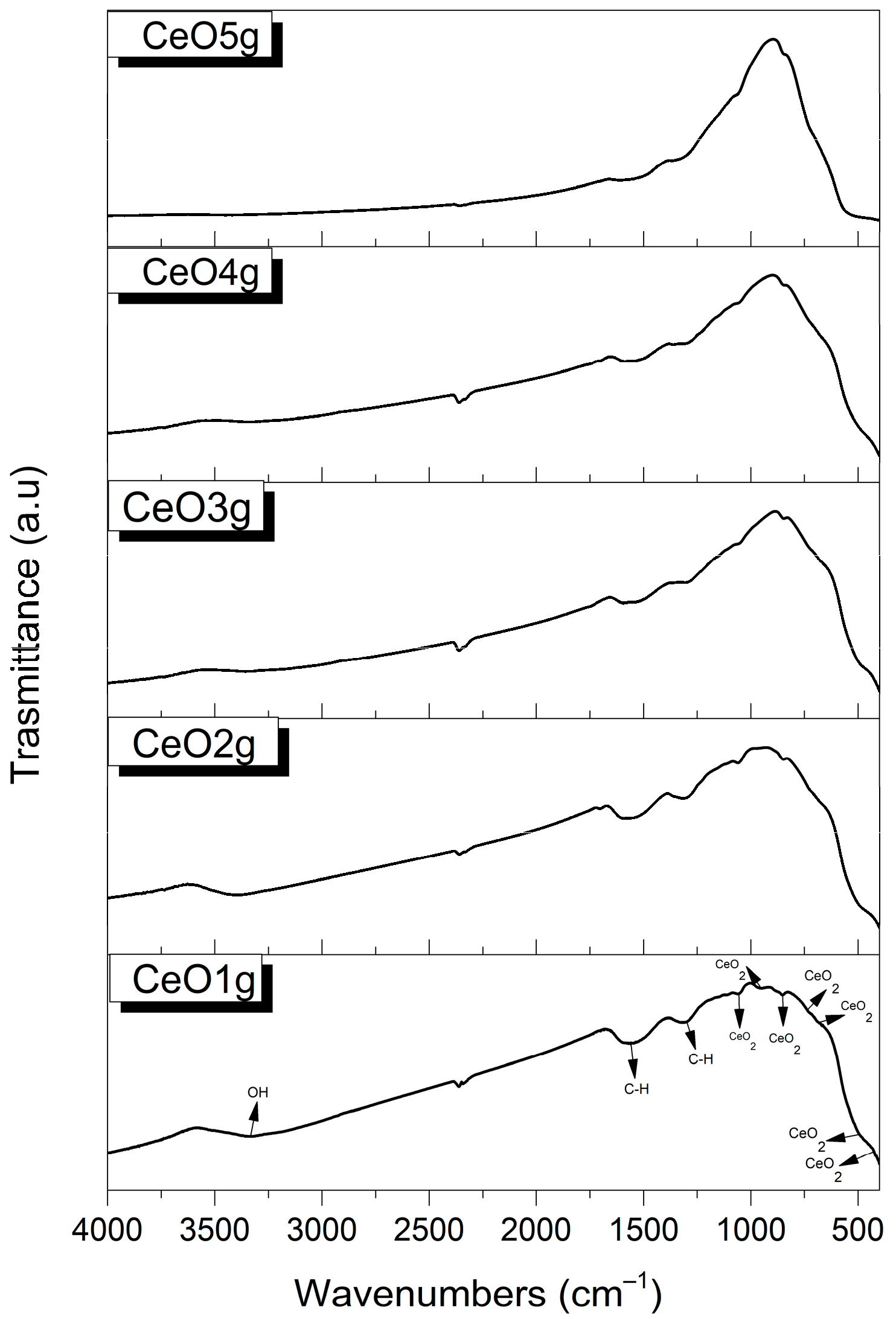
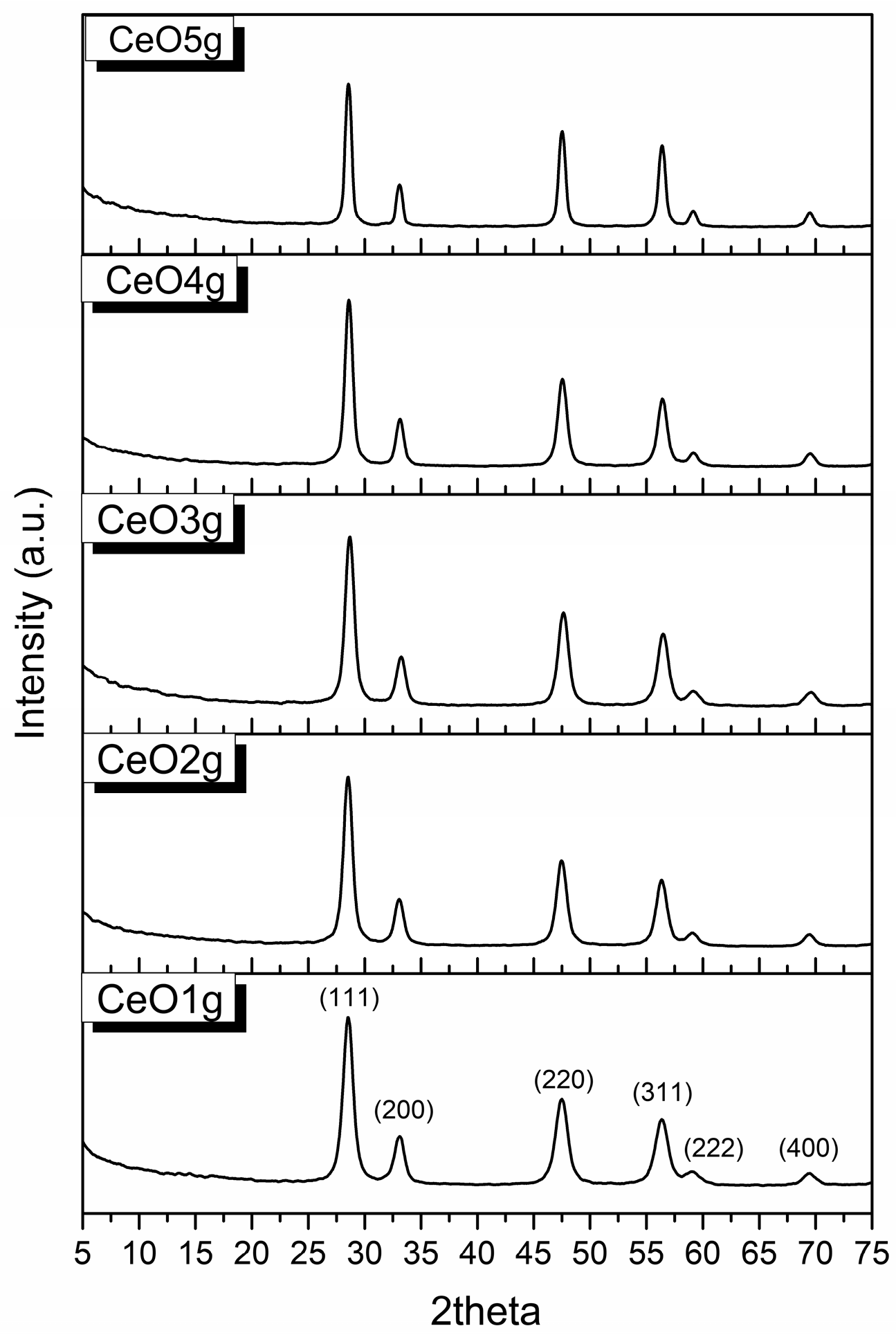
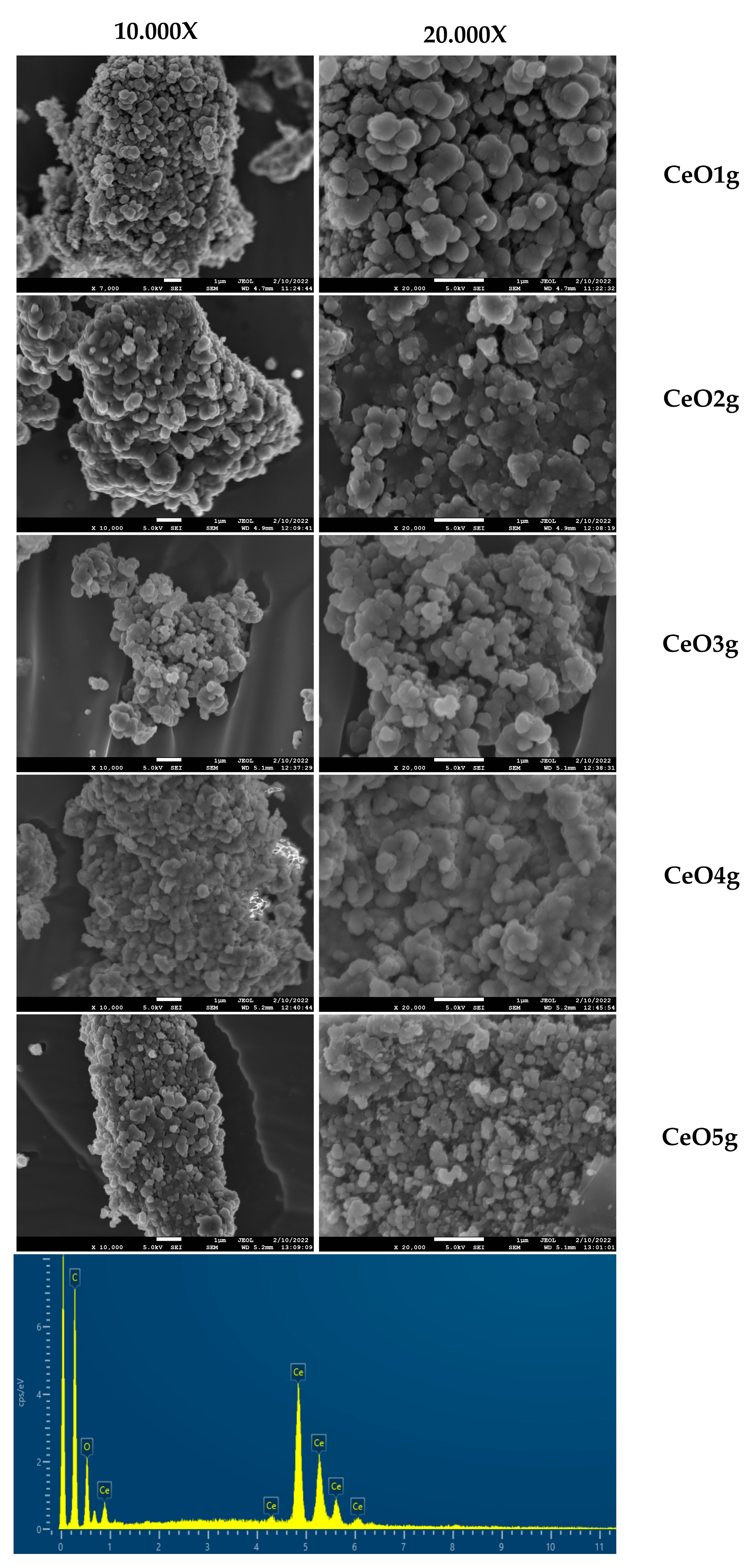
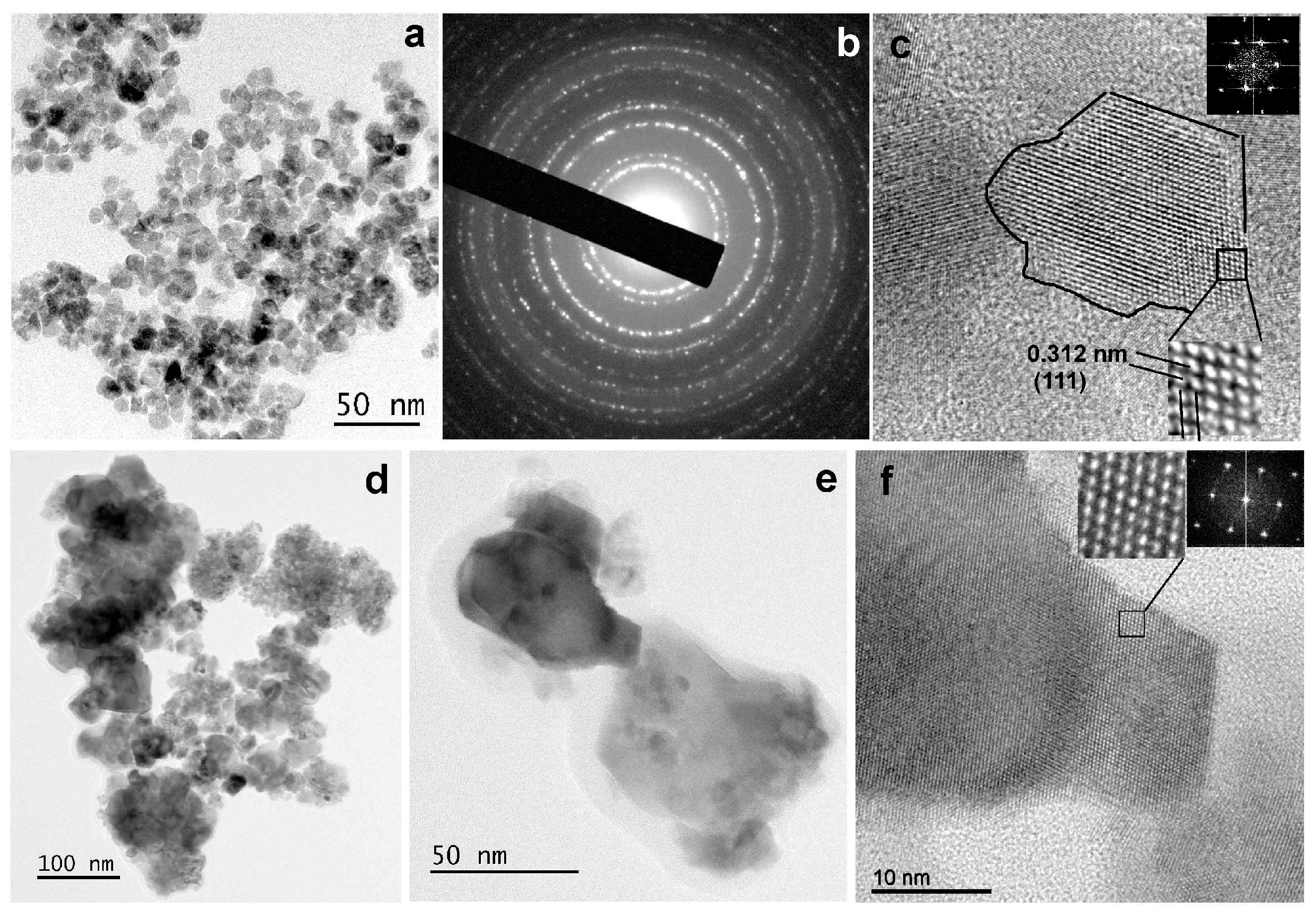
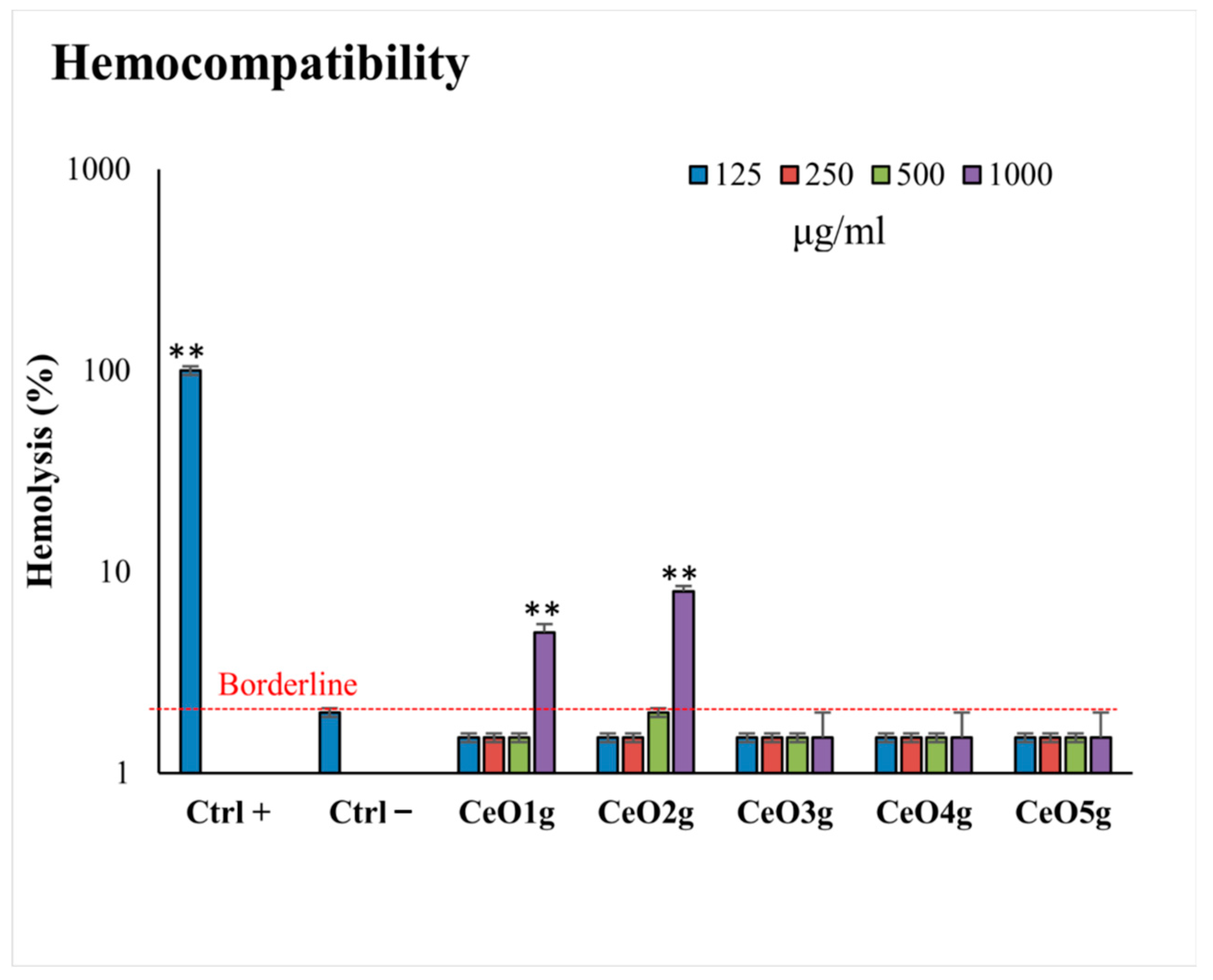
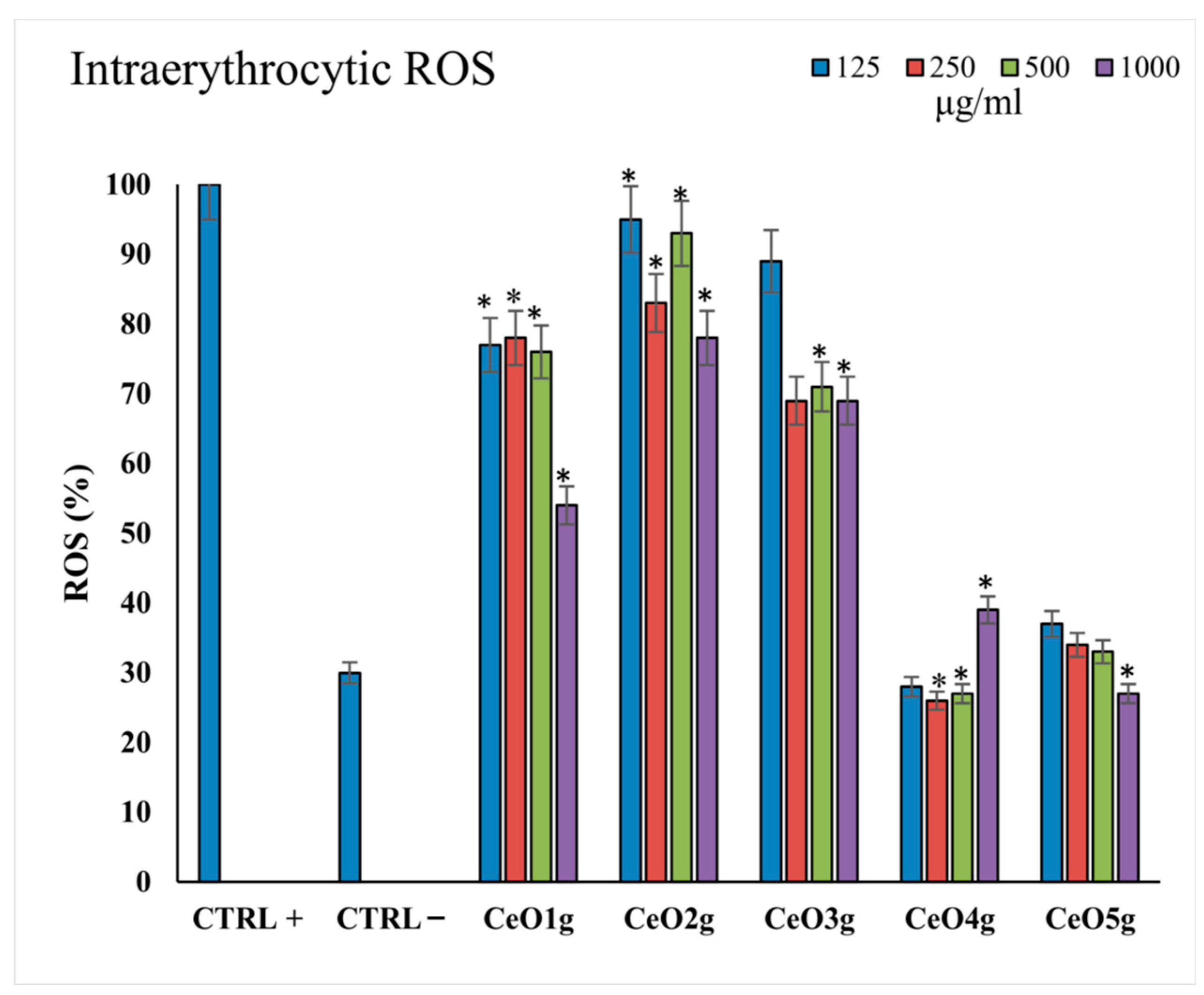
| Samples | Gelatin (g) | Ce Precursor (g) | H2O (mL) | Gelatin/Ce Precursor | Ce Precursor/Gelatin |
|---|---|---|---|---|---|
| CeO1g | 0.2 | 1 | 20 | 0.20 | 5.00 |
| CeO2g | 0.2 | 2 | 20 | 0.10 | 10.00 |
| CeO3g | 0.2 | 3 | 20 | 0.07 | 15.00 |
| CeO4g | 0.2 | 4 | 20 | 0.05 | 20.00 |
| CeO5g | 0.2 | 5 | 20 | 0.04 | 25.00 |
| Studies | Synthesis Method | Nanomaterials | Particle Size | RBCs Compatibility | ROS Scavenging | Calcination Temperature | Greater Precursor/Gelatin Ratio |
|---|---|---|---|---|---|---|---|
| Synthesis of CeO2 NPs | |||||||
| Present study | Sol-gel | CeO2 NPs | <10 nm | + | + | 550 °C | Larger NPs |
| Periyat 2019 [7] | Sol-gel | CeO2 NPs | 9–13 nm | 400 °C 500 °C 600 °C | |||
| Kurian 2014 [69] | Co-precipitation | CeO2 NPs | 4–37 nm | 400 °C 700 °C | |||
| Sol-gel | CeO2 NPs | 27.9–36.9 nm | 700 °C | ||||
| Gnanam 2011 [70] | Sol-gel | CeO2 NPs | 8 nm | 400 °C | |||
| Fudala 2021 [71] | Sol-gel | CeO2 NPs | 10 nm | 400 °C | |||
| He 2019 [41] | Sol-gel | CeO2 NPs | 10 nm | 500 °C | |||
| Darroudi 2013 [51] | Sol-gel | CeO2 NPs | <10 nm | 120 °C 200 °C 400 °C 600 °C | |||
| Singh 2019 [72] | Co-precipitation | CeO2 NPs | 250–325 nm | 350 °C 400 °C 450 °C | |||
| Chen 2010 [73] | Co-precipitation | CeO2 nanopowders | 10 nm 80 nm 100 nm | 273 K 473 K 673 K 773 K 873 K 1073 K 1273 K | |||
| Turco 2019 [74] | purchased by Sigma code 544841 | CeO2 NPs | 5–40 nm | + | + | ||
| Liu 2009 [75] | thermal decomposition | CeO2 NPs | ~4 nm | + | + | 600 °C | |
| Li 2019 [27] | hydrothermal | CeO2 nanorods CeO2 nanocubes CeO2 nano-octah | 9.6 ± 1.2 nm 57.2 ± 17.5 nm 29.1 ± 11.7 nm | + + + | + + + | ||
| Synthesis of NPs using gelatin | |||||||
| present | Sol-gel | CeO2 NPs | <10 nm | + | + | 550 °C | Larger NPs |
| Darroudi 2011 [65] | UV irradiation | Ag NPs | 18.8 nm | ambient | Larger yields | ||
| Azad 2018 [66] | Sol-gel | LiMn2O4 nanopowders | 70 nm | 350 °C 550 °C 750 °C 850 °C | Larger NPs | ||
| Oliveira 2017 [76] | Sol-gel | Si-Al micro/mesopores | 700 °C | ||||
| Khorrami 2017 [77] | Sol-gel | KNN-NPs | 50 nm 100 nm | 500 °C 600 °C 700 °C 800 °C | |||
| Zak 2011 [78] | Sol-gel | ZnO NPs | 29 ± 5 nm 40 ± 10 nm 58 ± 15 nm | 400 °C 500 °C 600 °C 700 °C | |||
Disclaimer/Publisher’s Note: The statements, opinions and data contained in all publications are solely those of the individual author(s) and contributor(s) and not of MDPI and/or the editor(s). MDPI and/or the editor(s) disclaim responsibility for any injury to people or property resulting from any ideas, methods, instructions or products referred to in the content. |
© 2023 by the authors. Licensee MDPI, Basel, Switzerland. This article is an open access article distributed under the terms and conditions of the Creative Commons Attribution (CC BY) license (https://creativecommons.org/licenses/by/4.0/).
Share and Cite
Ioannou, M.E.; Pouroutzidou, G.K.; Chatzimentor, I.; Tsamesidis, I.; Florini, N.; Tsiaoussis, I.; Lymperaki, E.; Komninou, P.; Kontonasaki, E. Synthesis and Characterization of Cerium Oxide Nanoparticles: Effect of Cerium Precursor to Gelatin Ratio. Appl. Sci. 2023, 13, 2676. https://doi.org/10.3390/app13042676
Ioannou ME, Pouroutzidou GK, Chatzimentor I, Tsamesidis I, Florini N, Tsiaoussis I, Lymperaki E, Komninou P, Kontonasaki E. Synthesis and Characterization of Cerium Oxide Nanoparticles: Effect of Cerium Precursor to Gelatin Ratio. Applied Sciences. 2023; 13(4):2676. https://doi.org/10.3390/app13042676
Chicago/Turabian StyleIoannou, Maria Eleni, Georgia K. Pouroutzidou, Iason Chatzimentor, Ioannis Tsamesidis, Nikoletta Florini, Ioannis Tsiaoussis, Evgenia Lymperaki, Philomela Komninou, and Eleana Kontonasaki. 2023. "Synthesis and Characterization of Cerium Oxide Nanoparticles: Effect of Cerium Precursor to Gelatin Ratio" Applied Sciences 13, no. 4: 2676. https://doi.org/10.3390/app13042676
APA StyleIoannou, M. E., Pouroutzidou, G. K., Chatzimentor, I., Tsamesidis, I., Florini, N., Tsiaoussis, I., Lymperaki, E., Komninou, P., & Kontonasaki, E. (2023). Synthesis and Characterization of Cerium Oxide Nanoparticles: Effect of Cerium Precursor to Gelatin Ratio. Applied Sciences, 13(4), 2676. https://doi.org/10.3390/app13042676








